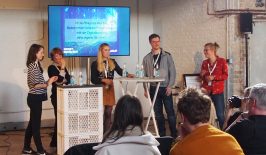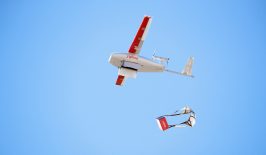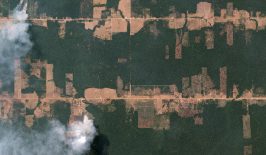Spanish ecopreneurs are turbo-charging reforestation efforts by combining drones and “smart seeds” to make the tree-planting process more efficient, faster and cheaper too.
Drones are increasingly being used to the benefit of society, to tackle climate change and achieve the SDGs. Drones are already being used to clean plastic out of our oceans, deliver medical supplies to remote areas, to clear landmines and to help much-needed reforestation efforts too.
Deforestation is both a cause and a consequence of climate change. Forests are key for regulating ecosystems, protecting biodiversity and absorbing carbon from the atmosphere, so cutting them down means more greenhouse gases being emitted into the atmosphere, and an increase in global warming. Approximately 2.6 billion tonnes of carbon dioxide (one-third of the CO2 released from burning fossil fuels), is absorbed by forests every year. While at the same time, the United Nations estimates that currently “million hectares of forests are being lost every year while the persistent degradation of drylands has led to the desertification of 3.6 billion hectares.” Moreover, the rising high temperatures are causing more and more brutal fires worldwide. The recent (and ongoing) fires in the Amazon have been just one shocking and wide-reaching example of that. This summer, north of the Arctic circle was also burning at a rate that the WMO described as “unprecedented”.
Conventional reforestation efforts are both resource- and time-intensive. That’s why the Spanish startup CO2 Revolution is using big data, drones and a new type of “smart seed” to provide a solution to reforestation on a large scale, to plant a whole ecosystem in a tenth of the time and at a fraction of the cost. The company has ambitious plans to plant up to 10 million trees over the next ten years.
Juan Carlos Sesma, the man behind CO2 Revolution is convinced that the only way to truly effectively offset humanity’s growing carbon footprint is to grow whole new ecosystems. So he left his day job behind and set out to create a startup that uses digital technologies to make reforestation more efficient.
Speeding up the tree-planting process, step by step
The planting is carried out in three stages. The first is an information-gathering phase, where a drone is sent out to collect data using a spectrographic camera, GPS technology and cartography tools, detecting variables such as temperature, rainfall, soil types and native plant species. The data is then crossed with data on local population, requirements and soil legislation, among other things, in order to extract information about an optimal planting pattern and to find the best spot to throw each seed.
Then the second technology comes into play. The team produces various different types of “smart seeds” or “Iseeds”, feeding the parameters they have collected into the seed pod. She seeds are matched to the diversity of the native ecosystems and include not only trees but also other necessary plants such as grass, flowers and shrubs, so that a complete ecosystem can be created.
“The seeds we use are treated in the laboratory and coated with gelatinous polymers, which ensure that they flower at the exact moment they receive water and that they are protected from being eaten by animals,” explained the co-founder Javier Sánchez in a press release about their project. The seed is enclosed in a sort of biodegradable capsule, which also contains elements such as ecological fertilizers, pesticides and even solid water polymers. According to the company, these components encourage germination, while at the same time protecting the seeds and preventing them from drying out. This helps them ensure that at least 80 percent of the seeds thrown will develop into a plant.
The last step is to plant the seeds with the help of a CO2 Revolution drone equipped with GPS and following the planting plans they have created. The seed tanks on the drones are 3D-printed and can hold up to 10,000 seeds at a time.
His solution makes it possible to plant around 100,000 trees in 5 hours, after a successful pilot project in late August proved – the reforestation of Spain’s Alto Tajo National Park, which lost 1200 hectares of vegetation in a fire in 2012. According to the company, the whole process cost a tenth of what other current methods cost. Following this and two other successful projects in Spain, the company now wants to expand to other European countries with similar legislation and maybe even take the project global. Another company is already using a similar technology to plant mangrove forests in Myanmar. Here’s hoping Brazil will be next.






